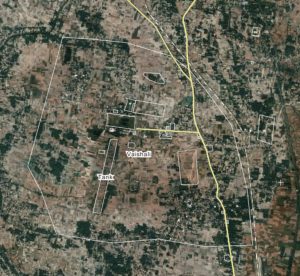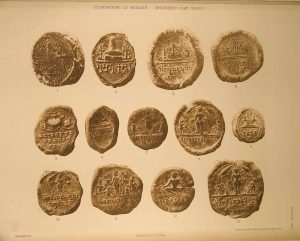
Vaishali (Bihār). Satellite view (Wikimapia).
Basarh, excavated area (Wikicommons).

Seals excavated at Basarh, Archaeological Survey of India, Annual Report, 1903-04; the seal top left is that of Dhruvasāmīnī (Zenodo).
| Metadata | |
|---|---|
| Object ID | OB00015 |
| Title | Basarh Clay Seal of Dhruvasvamini |
| Subtitle | |
| Inscription(s) | IN00016 |
| Child Object | |
| Parent Object | |
| Related Objects | |
| Responsibility | |
| Author | |
| Metadata recorded by | Dániel Balogh |
| Authority for metadata | |
| Metadata improved by | Dániel Balogh |
| Authoriy for improved | |
| Description | |
| Material | Clay / terracotta |
| Object Type | Seal |
| Dimensions: | |
| Width | 4.5 |
| Height | 6.3 |
| Depth | |
| Weight | |
| Details | An oval terracotta seal with a single-line border around it. The top part shows a seated lion facing proper right, separated from the inscription by a faintly preserved horizontal line. |
| History | |
| Created: | |
| Date | |
| Place | Vaiśālī |
| Other ancient history | |
| Found: | |
| Date | |
| Place | |
| Other modern history | |
| Latest: | |
| Date | |
| Place | |
| Authority | |
| Details | Found by Bloch in excavations in 1903-04 at the village of Basarh (ancient Vaiśālī), Muzaffarpur District, Bengal (map of site on plate XXXI, adjacent to ARASI 1903-04: 82). The seals were found in the Fort, at a depth of 3 metres, at the site where according to local tradition the palace of Rājā Bisāl once stood (detail map on plate XXXIII, adjacent to ARASI 1903-04: 88). The seals were in a room 10 metres square without any doorways, so it was evidently a subterranean vault (or refuse pit). A total of about 720 pieces of clay, with over 1100 seal impressions (of about 120 varieties), were recovered. All or most of these clay pieces seem to have been presses on strings used to tie letters. Beside the principal specimen, two more specimens of this seal impression were found, both "broken and very indistinct" (ARASI 1903-04: 107). |
| Notes | |
